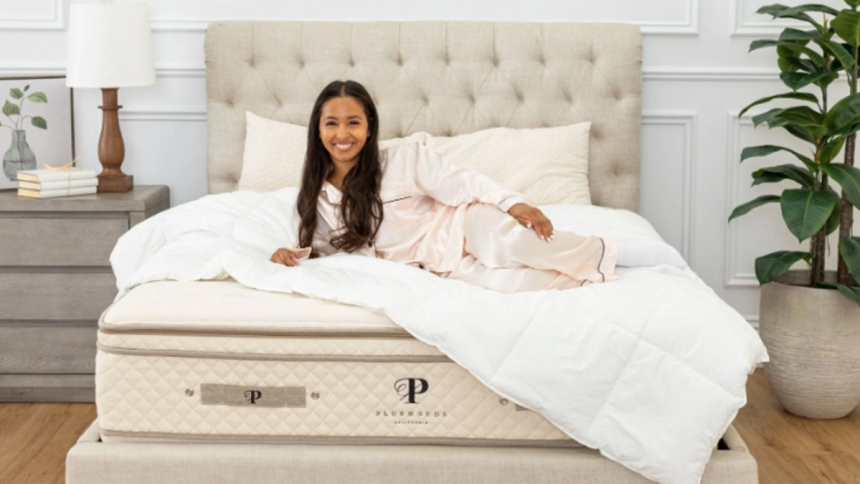Lately, there’s been a noticeable shift in how people approach sleep comfort—plush mattresses are taking center stage. More and more shoppers are leaning toward softer beds that promise not only luxury but also deep, restorative rest. You’ll find them everywhere now: in trendy showrooms, rave online reviews, and even luxury hotel rooms.
But is the buzz around plush mattresses just hype, or do they actually offer a better night’s sleep?
Let’s unpack what makes these mattresses unique, weigh the pros and cons, and find out whether softness truly equals better sleep.
What Is a Plush Mattress?
A plush mattress is a soft yet supportive bed designed to contour closely to your body. It’s often described as having a “cloud-like” feel. Unlike firm or medium-firm options, plush mattresses compress more easily under weight, offering a sinking sensation that hugs the body—especially at the shoulders, hips, and lower back.
Manufacturers achieve this softness through multiple layers of foam (like memory foam or latex), pillow tops, and sometimes even specialized coil systems. They’re typically marketed toward side sleepers or anyone looking for extra cushioning without sacrificing support.
Why Are Plush Mattresses Gaining Popularity?
The plush mattress comfort trend isn’t just about luxury—it’s about evolving consumer needs and advancements in sleep science. Here’s why people are gravitating toward softer sleep surfaces:
1. Improved Pressure Relief
For individuals with joint pain or pressure point discomfort, plush mattresses provide much-needed relief. The soft upper layers evenly distribute weight, minimizing stress on the shoulders and hips, especially for side sleepers.
2. Better Sleep Experience
Let’s face it—plush mattresses feel luxurious. The soft top layers can give you the feeling of sleeping on a hotel-quality bed every night. The sensory appeal alone is enough to convert many former firm-bed fans.
3. Rise in At-Home Wellness
With the growing focus on wellness and self-care, people are investing more in their sleep. Plush mattresses align with the idea of indulgent rest and rejuvenation, making them a favorite among those looking to upgrade their sleep environment.
Is Softer Always Better?
While the comfort level of a plush mattress is appealing, it’s not a one-size-fits-all solution. Here are a few factors to consider when asking whether softer is better:
1. Sleep Position Matters
- Side Sleepers: Often benefit the most from plush mattresses. They help reduce pressure on the shoulders and hips.
- Back Sleepers: May prefer a medium-plush option to ensure spinal alignment.
- Stomach Sleepers: Usually need a firmer mattress to prevent excessive sinkage, which can lead to back pain.
2. Body Weight and Type
Heavier individuals may find plush mattresses less supportive over time, as the materials can compress too much under pressure. In contrast, lighter sleepers often experience the full contouring benefits without compromising support.
3. Health Considerations
People with certain back conditions may need more structure than what plush mattresses typically offer. While the softness can initially feel great, it may not provide enough support for those needing firm spinal alignment.
Pros and Cons of Plush Mattresses
Here’s a quick breakdown of the advantages and disadvantages:
Pros:
- Exceptional comfort and cushioning
- Great for side sleepers and lightweight individuals
- Luxurious feel that promotes relaxation
- Excellent motion isolation (especially in foam models)
Cons:
- May lack long-term support for heavier sleepers
- Not ideal for stomach sleepers
- Can trap heat, depending on the materials
- Might be difficult to move on (you “sink” more)
Materials That Make the Difference
Not all plush mattresses are created equal. The materials used significantly impact the comfort, durability, and feel:
1. Memory Foam
Known for deep contouring, memory foam plush mattresses are popular for pressure relief and motion isolation. However, some models can sleep hot unless infused with cooling technology like gel or copper.
2. Latex
Latex offers a plush feel with added bounce and breathability. It’s ideal for eco-conscious buyers seeking comfort without the “stuck” feeling of traditional memory foam.
3. Hybrid
Combining coils with plush foam or latex, hybrids offer a balanced mix of softness and support. They’re a good option for those who want the plush experience without sacrificing spinal alignment.
Tips for Choosing the Right Plush Mattress
Ready to hop on the plush mattress comfort trend but not sure where to start? Here are some tips to help you choose the right one:
- Test It Out (If Possible): Try lying in your preferred sleep position for at least 10–15 minutes.
- Check for Zoned Support: Some plush models offer firmer zones under the lumbar region for added support.
- Look for Sleep Trials: Many online brands offer 90- to 365-night trials so you can make sure it’s right for you.
- Don’t Forget the Foundation: Plush mattresses often work best with a solid or adjustable base to support their structure.
- Review the Warranty: Opt for brands that back their products with at least a 10-year warranty.
Final Thoughts: Is Softer Really Better?
The answer depends on your personal needs, preferences, and body type. The rise of plush mattresses reflects a broader shift toward personalization and comfort in the sleep industry. For many, the combination of pressure relief, luxury feel, and modern materials makes plush mattresses a dream come true.
However, softness doesn’t always mean better. The best mattress is one that offers the right balance of contouring and support for you. Whether you’re a side sleeper chasing that “cloud nine” feel or someone needing extra lumbar structure, there’s likely a plush (or plush-hybrid) mattress out there that fits the bill.
As the plush mattress comfort trend continues to grow, it’s clear that the sleep industry is leaning into softness—but always with an eye on support, alignment, and long-term restfulness.
Interested in trying a plush mattress for yourself? Make sure to research thoroughly, read customer reviews, and take advantage of trial periods. The perfect night’s sleep might just be one mattress away.
Lynn Martelli is an editor at Readability. She received her MFA in Creative Writing from Antioch University and has worked as an editor for over 10 years. Lynn has edited a wide variety of books, including fiction, non-fiction, memoirs, and more. In her free time, Lynn enjoys reading, writing, and spending time with her family and friends.















